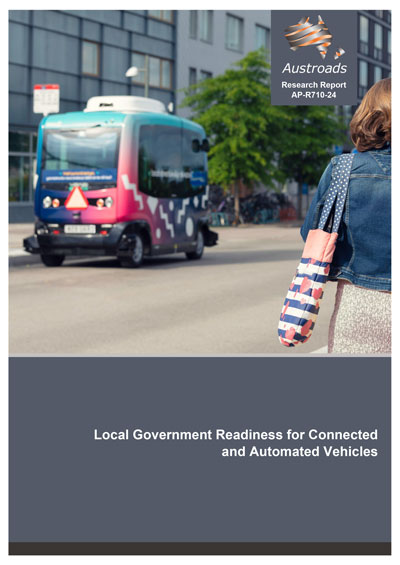Connected and Automated Vehicles

- Publication no: AP-R710-24
- ISBN: 978-1-922994-34-9
- Published: 22 June 2024
- PDF (free) Download
This report identifies the range of connected and automated vehicle (CAV) readiness needs and priorities across Australian and New Zealand local governments, and proposes options for resources and tools that address them. It was developed through review of existing publications and material, and stakeholder engagement and consultation with local government (LG) stakeholders.
Several key topics were identified as being important for LGs to support CAVs. These included: legal considerations, land use and transport planning, physical infrastructure readiness, digital infrastructure readiness, capability building, road safety considerations, managing traffic movements, financial impacts, environmental and socio-economic impacts, and stakeholder and community readiness.
An LG CAV Preparedness Framework is proposed to accommodate different topic information maturity and LG stakeholder needs. This Framework will provide context and information for overall LG CAV preparedness, act as a tool for LG CAV readiness assessment (i.e. support current and future state assessments) and serve as a basis for LG roadmap development.
Watch a webinar with David Yee and Andrew Somers designed to help people working in local government across Australia and New Zealand to navigate the evolving landscape of connected and automated vehicles.
Local Government Readiness for Connected and Automated Vehicles from Austroads on Vimeo.
- Summary
- 1. Introduction
- 1.1 Purpose
- 1.2 Scope
- 1.3 Methodology
- 1.3.1 Stage 1 Research and Review of Existing Material
- Preliminary stakeholder consultation
- 1.3.2 Stage 2 Research and Review of Existing CAV Material
- 1.4 Key Terms
- 2. Context of Future Vehicles and the Role of Local Government
- 2.1 What is a CAV?
- 2.2 Expected CAV Development
- 2.3 CAV Data Exchange and Data Use
- 3. Review of Existing CAV Readiness Resources
- 3.1 Australian and New Zealand Government CAV Readiness
- 3.1.1 National Transport Commission Automated Vehicle Program
- 3.1.2 Principles for a National Approach to Co-operative Intelligent Transport Systems (C-ITS) in Australia
- 3.1.3 New Zealand Regulations
- 3.1.4 The Impact of Automated Vehicles Operating on Aotearoa New Zealand Roads
- 3.1.5 New Zealand Ministry of Transport - Range of AV Types and Uses
- 3.1.6 NSW Connected and Automated Vehicle (CAV) Readiness Strategy
- 3.1.7 QLD CAVI and Road Safety Strategy
- 3.1.8 WA State Infrastructure Strategy 2022
- 3.1.9 VIC Infrastructure Strategy 2021–2051
- 3.1.10 South Australia Infrastructure Strategy
- 3.1.11 Local Government Transport Strategies Referring to CAVs
- 3.1.12 Local Government AV Trials
- 3.1.13 Austroads Digital and Physical Infrastructure Reports
- 3.2 Other International CAV Readiness Reports
- 3.2.1 Polis: Road Vehicle Automation and Cities and Regions (Europe)
- 3.2.2 CoEXist (Europe)
- 3.2.3 INFRAMIX (Europe)
- 3.2.4 TRB NCHRP Project 20-113F: Preparing for AVs and Shared Mobility (USA)
- 3.2.5 Ministry of Transportation of Ontario CAV Readiness Plan (Canada)
- 3.2.6 MetroPlan Orlando CAV Readiness Study (USA)
- 3.2.7 Virginia DOT CAV Program Plan (USA)
- 3.3 Summary
- 3.1 Australian and New Zealand Government CAV Readiness
- 4. Preliminary Stakeholder Consultation Findings
- 4.1 Preliminary Consultation Survey
- 4.1.1 LG Name, Type and Role
- 4.1.2 Previous CAV Experience
- 4.1.3 LG Preparedness to Support CAVs
- 4.1.4 Existing Materials, Resources or Supporting Documents
- 4.1.5 Aspects of CAVs Supported by Existing Materials, Resources or Documents
- 4.1.6 Awareness of Austroads CAV Publications
- 4.1.7 Highest Priority CAV Support Topics for LGs
- 4.1.8 LG CAV Readiness Support Resources
- 4.1.9 Project Reference Group
- 4.2 Summary of Preliminary Consultation Findings
- 4.1 Preliminary Consultation Survey
- 5. Consolidated List of Key Topic Areas for LG CAV Preparedness
- 6. Second Stakeholder Consultation Findings
- 6.1 Second Consultation Survey
- 6.1.1 Survey Questions
- 6.1.2 Survey Evaluation Criteria
- 6.1.3 Survey Results
- 6.2 Consultation Workshop Results Review and Discussion
- 6.3 Summary of Second Consultation Findings
- 7. Local Government CAV Support Actions
- 7.1 Maturity of Available Information
- 7.2 Support Tools and Resources
- 7.3 LG Preparedness Framework
- 7.4 Other Supporting Actions
- 8. Conclusions
- References
- Appendix A Initial Survey
- Appendix B Second Survey
